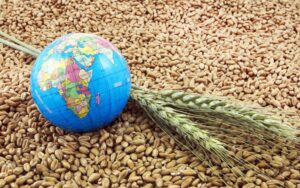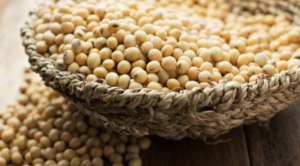
Ukraine currently has access to export products in 340 trade areas of agricultural products, and plans to open 240 more markets in the next five years, said Serhiy Tkachuk, head of the State Service for Food Safety and Consumer Protection.
“We are one of the key state agencies responsible for opening new markets: we work with more than 60 countries on plant and animal products. We intend to open 240 new markets within five years. At the same time, the process of our country’s integration into the EU continues. And if we look at Chapter 12 on food security, veterinary and phytosanitary policy, it alone accounts for 19% of the requirements that Ukraine faces in general. So, there is a lot of work to be done, but we will manage, because we are responsible to our defenders and future generations,” the Ministry’s press service quoted him as saying at the Kyiv International Forum.
Tkachuk also reminded that the service is one of the key players in opening new international markets for Ukrainian business, as it is responsible for controlling 100% of Ukrainian agricultural exports.
“Implementation of EU requirements is now a priority for Ukraine. But at the same time, it is important for us to defend our own interests – the interests of Ukrainian business, first and foremost. In particular, our tasks now include maintaining stable trade with partner countries, removing barriers to exports, lifting restrictions on exports of certain products, and simplifying certification and transit procedures,” he added.
The Head of the State Service of Ukraine on Food Safety and Consumer Protection also spoke about the digitalization of all processes and services of the agency. “According to him, the digitalization will reduce the time for obtaining permits from 5-20 days to 1-5 days. In addition, certain services, such as capacity registration, will be provided in real time, i.e. within a few minutes.
“It will be possible to apply for services online, without unnecessary trips, queues and stop documents, as well as to see the status of the service in your own online user account; see all inspections and their results; and pay for services easily through a single system with automatic generation of payment documents,” Tkachuk said.

In October 2024, Ukraine exported the record monthly volume of soybeans – 675 thsd tonnes, up almost three times compared to September and 20% compared to the previous high of 561.5 thsd tonnes in October 2019, APK-Inform news agency reported.
“The significant increase in soybean shipments since the beginning of the season-2024/25 is due to a number of factors, in particular, the growing demand for the Ukrainian crop from the key importers – the EU and Turkey – amid the decline in its price in July-August,” the analysts said.
At the same time, many exporters were in a hurry to ship, expecting a reduction in trade after the introduction of the minimum price mechanism for exports of certain types of goods, in particular soybeans. As experts reminded, the Ministry of Agrarian Policy of Ukraine noted that the law regulating minimum prices for agricultural exports will come into force no later than December 10, 2024.
According to them, Ukraine has already exported 918 thsd tonnes of soybeans since the beginning of 2024-2025 marketing year, which is 44% higher than in the same period of the previous season. The EU countries accounted for almost half of the total exports (47%). The growth in this direction is estimated at 54%. Ukrainian soybean supplies to Turkey increased by 10%.
In addition, shipments to Pakistan increased significantly in September-October, bringing the country’s share to 12% of total exports.
This is a relatively new export destination for Ukrainian soybeans, opened in May 2024, APK-Inform stated.

In 2023, Ukraine exported 45.8 thousand tons of honey to the European Union, with 28% of imports of this product from Ukraine, said Olena Dadus, Deputy Director of the Agrarian Development Department of the Ministry of Agrarian Policy and Food.
“The markets of the European Union are key for honey exports, as Ukraine is the second largest exporter of honey to the EU, accounting for 28% of all imports of this product by the bloc. According to the Register of Export Capacities, about 72 Ukrainian enterprises are engaged in the supply of honey abroad,” the press service of the Ministry of Agrarian Policy and Food quoted her as saying at the Honey Forum ”European Integration of the Ukrainian Honey Industry: Challenges and Opportunities.”
According to the State Customs Service and the State Statistics Committee, honey exports in 2023 amounted to 55.4 thousand tons worth $121.4 million, including 45.8 thousand tons (93.6% of total exports) worth $94.9 million. At the same time, in the first half of 2024, honey exports to the EU amounted to 40.6 thousand tons worth $70.7 million.
The Ministry of Agrarian Policy recalled that the main countries of honey export in 2023 were the European Union (Germany, Poland, Spain, France, Belgium, Romania, Italy, Hungary, Greece) and the United States.
As reported, as part of Ukraine’s association with the European Union, Ukrainian companies were entitled to supply 18.507 thousand tons of honey to the EU market free of duty starting June 5, 2024. After this volume was exhausted, the EU resumed quotas on August 21. From January 1, 2025, and until June 5, 2025, a new tariff quota will be introduced, which corresponds to 5/12 of the threshold set for the emergency braking.

In October 2024, Ukraine exported a record volume of goods worth more than $3.8 billion, which is 18.7% more than in September this year, First Deputy Prime Minister and Minister of Economy Yulia Svyrydenko said.
“A significant increase in exports in October was made possible by an increase in the supply of agricultural products. In October, exports of agricultural products increased by 32.3% in value and 33.8% in weight. This made it possible to increase the physical volume of exports to 10.9 million tons, which is 26.2% more than in September this year. We owe these achievements to our defenders, who ensure the operation of the sea corridor despite threats from the enemy. In October, exports by sea grew by 28.2% in monetary terms and 37.1% in weight,” the press service of the Ministry of Economy quoted her as saying.
According to Svyrydenko, according to preliminary data, since the beginning of 2024, exports of goods have totaled almost $34.6 billion.
“Given the current dynamics of exports in goods, we can predict with some caution that this year’s exports in monetary terms will exceed last year’s figures. Let me remind you: In 2023, it was $36.2 billion. In terms of physical volumes, we have already exported more in the first 10 months of 2024 than in the whole of last year. This is 110 million tons in total for 10 months of this year, compared to 100 million tons in 2023,” the Minister of Economy explained.
Taras Kachka, Deputy Minister of Economy and Trade Representative of Ukraine, said that in October, Ukraine exported the most sunflower, safflower or cottonseed oil in monetary terms – by $447.2 million, or 481.3 thousand tons, corn – by $447.2 million, or 481.3 thousand tons. tons, corn – by $363.6 million, or 1.9 million tons, respectively, wheat – by $318.2 million, or 1.6 million tons, soybeans – by $260 million, or 675 thousand tons, rapeseed – by $239.2 million, or 476.3 thousand tons, iron ore and concentrates – by $166.8 million, or 2.5 million tons.
Ukrainian producers exported most of their goods to Poland, Germany, Spain, Italy, Italy, and Turkey. Overall, in October, Ukraine exported $2.38 billion worth of goods to the EU, up 15.8% compared to September.
“The European Union is Ukraine’s key trading partner. That is why we are making every effort to provide our exporters with the most favorable conditions for access to European markets and integration of Ukrainian producers into European value chains,” summarized the Ukrainian trade representative.

Ukraine and China are working to open the Chinese market for Ukrainian peas, poultry, corn, and fish products, the press service of the State Service for Food Safety and Consumer Protection reports.
“China is an important market for national exporters of agricultural products, so on behalf of the head of the State Service of Ukraine for Food Safety and Consumer Protection, Serhiy Tkachuk, the service and the competent authority of China continue to interact on a regular basis. Our goal is to open seven new markets. This is a long process of coordination, but step by step we are succeeding,” said Oleh Osiyan, First Deputy Head of the State Consumer Service, at a meeting with representatives of the General Administration of Customs of the People’s Republic of China (GACC).
The parties discussed draft bilateral international agreements on the export of peas, wheat flour, pet food, beef, corn, poultry, and wild-caught aquatic products from Ukraine to China. Each of these documents is at a different stage of development and approval.
“Currently, the protocol on peas is at the stage of finalizing domestic approval in Ukraine, and the texts have been sent to the competent authority of China for consideration. This is one of the markets that is at the final stage of opening. After the signing of the bilateral protocol, new opportunities for pea exports will open up for Ukrainian agricultural businesses,” said Vadym Chaikovskyi, Deputy Head of the State Service of Ukraine for Food Safety and Consumer Protection and Chief State Phytosanitary Inspector of Ukraine.
It should be reminded that the last Ukrainian product to be granted access to the Chinese market was honey. The form of the health certificate for its export was agreed upon earlier this year.
The requirements of the countries of destination for the export of food products of animal and plant origin are published on the official web portal of the State Service of Ukraine on Food Safety and Consumer Protection.
“Currently, our Chinese colleagues are considering draft protocols on the export of poultry and fish. The State Service of Ukraine on Food Safety and Consumer Protection sent its proposals on the text of the protocol in the fall. The protocol on wild-caught aquatic products has already passed domestic approval and is at the stage of final approval by the Chinese side. The texts of the protocols on beef and pet food are also undergoing the stage of internal approval,” said Volodymyr Kusturov, Deputy Head of the State Service of Ukraine for Food Safety and Consumer Protection and Chief State Veterinary Inspector of Ukraine.
Representatives of the State Food and Consumer Service and the GACC discussed in detail the steps for further cooperation, draft bilateral agreements, and agreed to continue active cooperation on the development of international trade between Ukraine and China.

Agrotrade Agroholding has completed harvesting industrial hemp, which it grew on an area of about 230 hectares in Chernihiv region, the company’s press service reported on its Facebook page.
According to the report, 2024 was the final year of the agricultural holding’s hemp cultivation trials. The company has determined the best technologies and herbicide plant protection products, and understood the technical features of working with this crop.
“By changing approaches to seed harvesting and processing, we have obtained very good quality grain indicators: the oil content is high, and the acidity and peroxide values are low. The yields were slightly lower than we expected. The hemp was dry and the fiber was easily separated from the bast, so technical support during harvesting was the biggest challenge. The reason is that you can’t just pick up any harvester at any time: you need to know exactly what kind of hemp is best for what time and what kind of harvester will be optimal. These are the technical features of hemp that we have figured out,” says Oleksandr Ovsyanyk, Director of Agrotrade’s Agricultural Department.
“This year, we started harvesting later to get higher quality seeds. Due to the peculiarities of the variety and the year in general, threshing took longer than expected.
The agricultural holding emphasized that the Ukrainian market is not yet ready to consume large quantities of hemp grain, so this year’s harvest will be exported. If it can be sold profitably and in large volumes, the company will consider expanding the area.
Agrotrade Group is a vertically integrated holding company with a full agro-industrial cycle (production, processing, storage and trade of agricultural products). The company cultivates over 70 thousand hectares of land in Chernihiv, Sumy, Poltava and Kharkiv regions. Its main crops are sunflower, corn, winter wheat, soybeans and rapeseed. It has its own network of elevators with a one-time storage capacity of 570 thousand tons.
The group also produces hybrid seeds of corn and sunflower, barley, and winter wheat. In 2014, a seed plant with a capacity of 20 thousand tons of seeds per year was built on the basis of Kolos seed farm (Kharkiv region). In 2018, Agrotrade launched its own brand Agroseeds on the market.
Vsevolod Kozhemiako is the founder and CEO of Agrotrade.